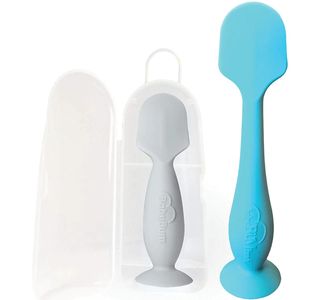.jpg?fit=outside&w=1600)
Sweet Baby Skin
December 1, 2019 | by anna rogers
One of my favorite things about snuggling a sweet baby is the softness of their new, flawless skin. But there are times when baby’s skin isn’t perfect, and for parents, rashes and skin conditions can be scary and hard to navigate.
“Newborn skin faces a daunting challenge – emerging from a cozy, dark, warm, watery world into the lighted, cold, airy environment, making it a wonder that more doesn’t go wrong,” says Billings Clinic Dermatologist Samuel Reck, MD.
With the many potential skin conditions baby may face, it’s helpful for parents to know which conditions are normal and which require immediate or eventual care from a physician. Dr. Reck gives us some tips for navigating these tough parental waters.
What are some common baby skin conditions that shouldn’t cause parents alarm?
“Babies frequently develop pinpoint bumps on the face and scalp that can be white milia, yellow sebaceous hyperplasia, or red erythema toxicum neonatorum (which sounds scary, but occurs in 40% of babies and is normal). Newborns often develop bumps that we call acne, which is caused by a yeast that lives on us all. That same ubiquitous yeast can also cause pink to white, greasy scale of the scalp, just like adult dandruff. Newborn babies’ skin is also hyper responsive to temperature changes, often giving a marbled hue (cutis marmorata) and blueish feet (acrocyanosis) in response to cool temperatures.”
How can parents interpret birthmarks on baby?
“Many babies will have birthmarks, the most common of which are salmon patches – pink colored marks on the forehead and eyelids (angel kisses) or back of the neck (stork bites). An angel kiss will fade whereas stork bites usually last a lifetime.
Some red birth marks, like a port-wine stain or a capillary malformation, should be seen by a physician as they can be a marker of underlying problems. Other red birthmarks are barely present at birth and rapidly grow over the first few months of life. These, hemangiomas of infancy, should also be seen by a physician as they can cause permanent damage.
Brown birth marks occur in a range of colors: café latte brown (café au lait macules), gray-brown marks on the lower back (dermal melanosis), or dark brown birthmarks (congenital melanocytic nevi) that can occur in all sizes, with or without dark hair, and anywhere on the body.”
When should parents seek a physician’s care for baby’s skin conditions?
- Red birthmarks around the eye or that are rapidly growing need to be seen as soon as possible.
- Rashes that blister, bleed, bruise, or appear painful need to be seen as soon as possible.
- All brown birthmarks should be discussed at your next well child check.
- Rashes that itch and scale and interfere with sleep or don’t resolve in a couple of weeks should be evaluated.
What are some other tips for caring for baby’s skin?
Diaper Rash
“Almost every baby will have a diaper rash at some point as both stool and urine break down skin when placed in direct contact with it. Studies have shown that disposable diapers with their superabsorbent materials reduce skin breakdown, create a favorable pH, decrease exposure to urine and stool, and better contain bacteria.
To treat diaper rash, first promptly change soiled diapers. Second, use disposable diapers. Lastly, apply a 40% zinc oxide paste at every diaper change. If the diapered skin becomes severe, painful, bleeding, appears bruised, or just won’t heal, you should discuss with your pediatrician.”
Eczema
“Within the first few months of life some infants may develop eczema (technically atopic dermatitis), an itchy, red, scaling rash with dry skin caused by the skin being formed with an ineffective barrier. Up to 20% of children will develop eczema.
Recent studies suggest that if a baby is at high risk of eczema (eczema is common in the family), applying a high-quality moisturizing ointment (Aquaphor) or cream (Vanicream) to the entire body every day may decrease his or her chance of developing eczema.”
Sun Protection
“Babies’ pigment forming cells, known as melanocytes, are not fully developed until six months, and baby skin is more permeable to sunscreen ingredients. When protecting your baby from the sun, a hat, shade, or sun protective clothing is the safest and most effective.”
Fun Find: Baby Bum Brush
Made of soft, flexible silicon, this diaper cream applicator is gentle on baby’s skin and keeps parents’ fingers clean. A suction cup base makes it perfect to keep handy at the diaper changing station!
Originally printed in the December 2019 issue of Simply Family Magazine
Never miss an issue, check out SFM's digital editions here!







